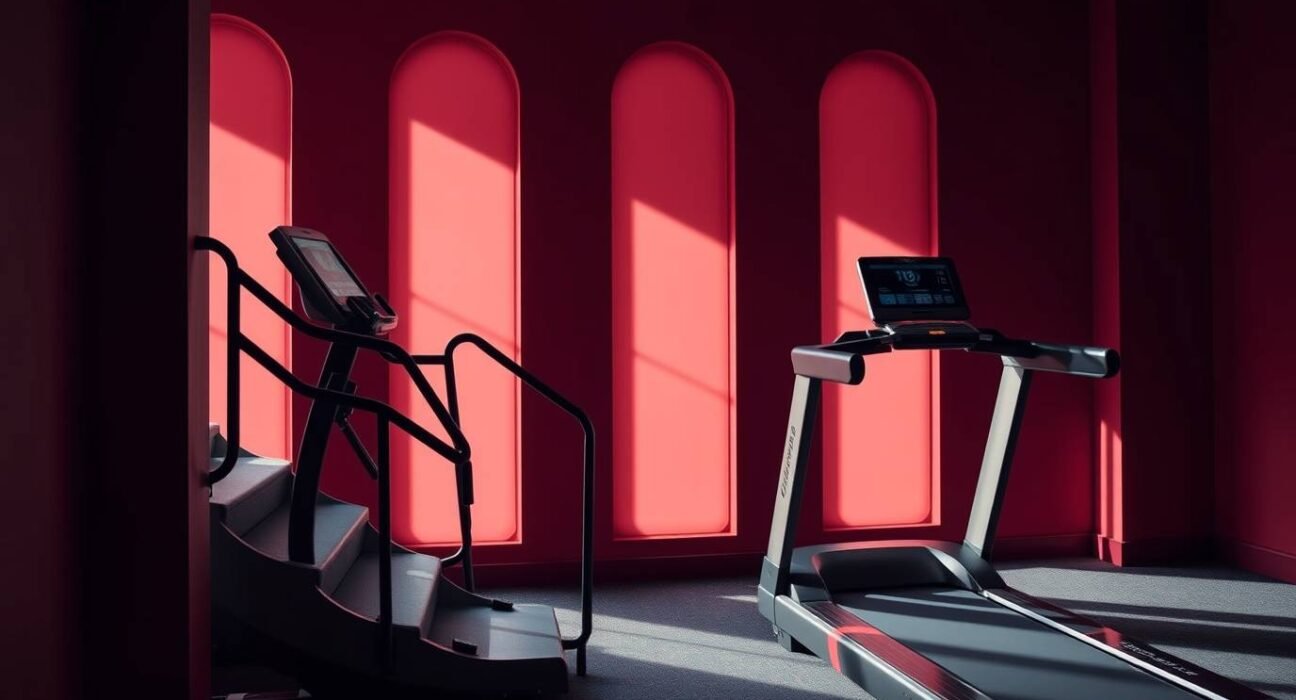Is the StairMaster BeThere are quite a few options out there when it comes to indoor cardio machines, but none offer quite the notoriety of the StairMaster and the treadmill. Both claim to enhance cardiovascular function, increase endurance, and aid weight management. But determining which machine is better — or better for you — can be tough. Is the StairMaster better than the treadmill or is it simply about personal preference and a chance at goals? In this 1,000-word guide, we’ll examine the ins and outs of each machine so that you can confidently choose the one that fits best into your fitness journey.
Read: How to Choose the Best Running Shoes for Men
Understanding the StairMaster:
The StairMaster was designed to simulate the sensation of ascending a flight of stairs. Later models are typically equipped with a repurposed revolving stairwell, putting you in a constant near-climb. This move activates several major muscles in the lower body — the quadriceps, hamstrings, glutes, and calves.
Key Benefits
- Lower-Body-Specific: One of the most pronounced drawbacks of the StairMaster is its lower-body focus. Since you need to lift your body weight for every step, you recruit the glutes, quads and hamstrings at extreme angles. In time, this can tone and strengthen these muscles efficiently.
- Quick Calorie Burn: The effort of climbing can raise your heart rate quickly, making it possible to burn a substantial number of calories in a shorter duration. This is especially useful for those who want efficient workouts.
- Joint-Friendly Approach: Though it may seem extreme, the StairMaster is generally a lower-impact exercise than running. If used correctly — not slouching over or bearing down too heavily on the rails — it can be relatively easy on the knees.
Drawbacks
- Monotony: The repetitive motion of stepping can get monotonous if you don’t vary your speed or take advantage of interval programs.
- Learning Curve: At first, it can be difficult to maintain proper posture and balance. Poor form (e.g. leaning forward) is less effective and can cause discomfort.
- Space and cost: A StairMaster doesn’t take up as much floor space as some other cardio machines do, but it often does require a good amount of vertical clearance, and the best models are expensive. That may scare off some shoppers looking for a less expensive home gym addition.
2- Understanding the Treadmill
The treadmill has become a mainstay of many gyms and home setups. You can walk, jog, or run at adjustable speeds and inclines, all in a controlled, indoor environment.
Key Benefits
- Versatility: The treadmill can accommodate an easy stroll or a forceful sprint, allowing you to customize your workout for your fitness level at any given time. Many treadmills also include preset programs for interval training, hill workouts, and more.
- Natural movement: most people already know how to walk or run, so there’s not much to learn. You can build up speed and incline as you go to ramp up the intensity, making it manageable for beginners and difficult for seasoned runners.
- Better Cardiovascular Endurance: Long walking and running build the strength of the heart and lungs considerably. You may find, over time, that you can run farther or you can walk at a faster pace without getting winded.
Drawbacks
- Higher Impact – While Running: Running has similar stress to the knees, hips, and ankles as if they are on a treadmill. While many modern treadmills are shock-absorbing, people with joint issues might find running uncomfortable or even exacerbating.
- Boredom Factor: If you’re logging a ton of miles, staring at the same wall or TV screen can get old. Listening to music, watching shows, or using virtual running apps can help stave off boredom, however.
- Space and Budget: Treadmills can also be large and pricey, especially the ones designed for high-speed running or heavier users. (Although there are foldable and more compact options, you still require enough of a footprint.)
3- Calorie Burn Comparison
Many people are interested in a straightforward question: Which machine burns more calories?
- StairMaster: Thanks to the constant lifting motion, a challenging StairMaster session can burn a significant number of calories. If you maintain an intense pace, your heart rate can remain in a high zone, leading to substantial calorie expenditure within a shorter timeframe.
- Treadmill: The caloric burn largely depends on speed and incline. Walking on flat ground at a leisurely pace may burn fewer calories than climbing on the StairMaster. However, running at higher speeds or walking on a steep incline can rival—or exceed—the calorie burn of a StairMaster workout.
Ultimately, both machines can deliver a high-calorie burn if used at challenging intensities. The “winner” often depends on personal effort and workout design.
4- Muscle Engagement and Fitness Goals
1- StairMaster:
- Leg Workout: The StairMaster works wonders for your legs and glutes אם you want to target those areas specifically. That stepping motion engages those muscles over and over, which can build endurance and definition.
- Leg and Core Stabilization: A good stair-climbing form calls for you to actively engage your core to stabilize your upper body.
2-Treadmill:
- Flexibility: You can prioritize endurance, speed or hill days. A slow incline walk can mimic the muscular focus of a StairMaster, whereas running faster builds aerobic capacity.
- Overall Cardio: In terms of cardiovascular conditioning, running is among the most effective exercise insgesamt. For those wanting to build race endurance, a treadmill is a great tool for practicing consistently in a controlled environment.
5- Time Efficiency
- StairMaster: You might find your heart rate skyrockets because it is an ongoing uphill ascent. Even 20 minutes can seem like a real workout. This high-intensity strategy works well for busy schedules.
- Treadmill: With sprints or steep inclines, you can make treadmill workouts just as rigorous. If you go at a more moderate intensity, it will likely take a bit longer to achieve the calorie burn or cardiovascular challenge of the StairMaster.
6- Practicality: Space, Cost and Noise
StairMaster:
- Space: The vertical construction requires a reasonable amount of ceiling height.
- Cost: A good StairMaster could be pricey, though lower-priced stepper options exist.
- Noise: A spinning mechanism that could create noise.
Treadmill:
- Space: Takes quite a bit of floor space, but foldable options can lessen the footprint.
- Price: Basic walking treadmills can be inexpensive, but high-end running treadmills can be an investment.
- Noise: The belt’s movement and footfalls can be noisy, especially if you live in an upper-floor apartment.
Who Should Use the StairMaster?
- People Wanting to Develop the Lower Body: The Split-step motion of the Stairmaster is great when your priority is defining the legs and glutes.
- People With Minor Joint Issues: Though all exercise can be hard on the joints if the impaired form is utilized, a StairMaster can be less jarring than running on a treadmill, provided you keep good posture.
- Busy Schedules: If you want a quicker workout that still packs a cardiovascular wallop, the StairMaster’s intensity can be a benefit.
Who Should Get the Treadmill?
- If you’re already a Runner or Interested in Running: When preparing yourself for a 5K, 10K or marathon, training on a treadmill is a much more realistic situation, where you can simulate pace and track distance, speed, and incline.
- Diverse Workouts: If you enjoy a little walk one day a little sprinting the next and maybe an incline hike another day, the treadmill’s versatility is appealing.
- Ease of Use: Walking and running are basic movements. It is easy for a beginner to start slowly and build up over time with a little learning curve.
Conclusion:
So, is the treadmill or the StairMaster better? So what do you need to have speaking at your event? The short answer: It’s up to you. Both machines also provide a great cardiovascular workout and allow you to burn calories in an effective way. The StairMaster excels if you’re after a lower-body-dominant workout that swiftly elevates your heart rate and is on the gentler side for the joints (when used correctly). The treadmill, meanwhile, remains an adaptable option that serves walkers, joggers and serious runners alike — offering adjustable levels of exertion and higher ease of use.
Before you finally decide, consider your fitness goals, the space you have at home and any limitations with regard to your joints or budget. If you’re able, sample both machines in a gym to see which one feels better on your body and keeps you motivated. At the end of the day, the best cardio machine is the one you’re actually going to use regularly. Whether it’s climbing virtual stairs on the StairMaster or racking up miles on the treadmill, consistency is what leads to real progress in fitness.
Disclaimer: Always seek the advice of a licensed healthcare provider before starting any new exercise program, especially if you are concerned about underlying health conditions or risk of injury.tter Than the Treadmill


























Leave feedback about this